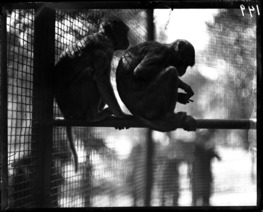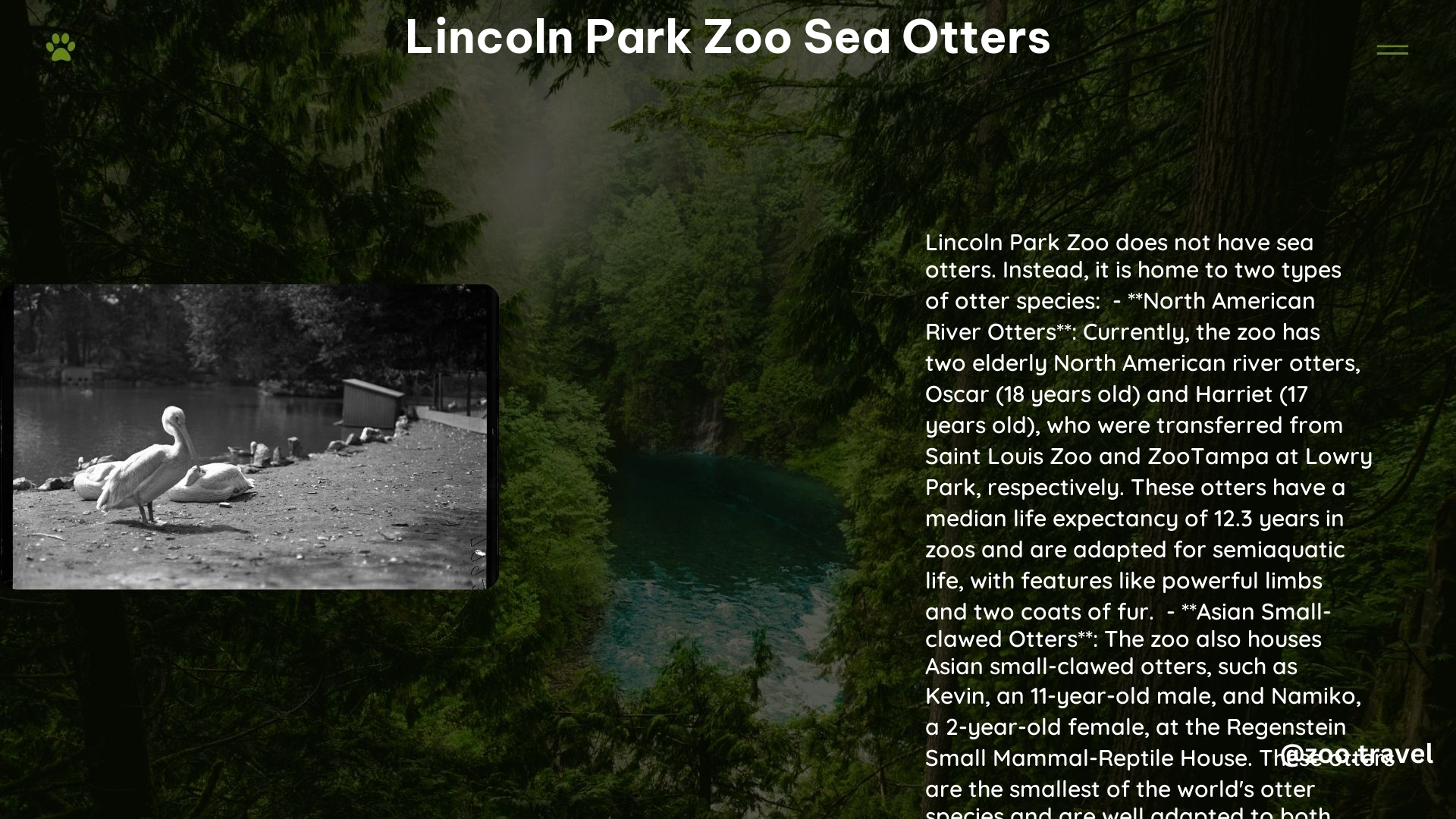Lincoln Park Zoo in Chicago is home to two fascinating otter species: the Asian small-clawed otter and the North American river otter. While sea otters are not present, these two species offer visitors a chance to observe and learn about the diverse world of otters. The zoo provides naturalistic habitats for these playful creatures, ensuring their well-being and offering educational opportunities for guests of all ages.
What Types of Otters Can You Find at Lincoln Park Zoo?

While Lincoln Park Zoo doesn’t house sea otters, it is home to two captivating otter species:
- Asian Small-Clawed Otters
- North American River Otters
Each species has its unique characteristics and habitat requirements, which the zoo has carefully replicated to ensure the otters’ comfort and well-being.
Where Are the Asian Small-Clawed Otters Located in the Zoo?

The Asian small-clawed otters reside in the Regenstein Small Mammal-Reptile House. Their habitat features:
- A cozy den for resting and privacy
- A naturalistic landscape with dirt and live plants
- A pool for swimming and exploration
This environment mimics their natural habitat, allowing visitors to observe these charming creatures in a setting that closely resembles their wild home.
Who Are the Asian Small-Clawed Otters at Lincoln Park Zoo?
Currently, the zoo houses two Asian small-clawed otters:
- Kevin: An 11-year-old male
- Namiko: A 2-year-old female
These otters have been paired together as part of a Species Survival Plan®, which aims to maintain healthy, genetically diverse populations of animals in zoos.
What Makes Asian Small-Clawed Otters Unique?
Asian small-clawed otters possess several distinctive features:
- They are the smallest otter species in the world
- Their partially webbed paws allow for greater dexterity
- They are highly social animals, living in family groups
- They communicate through various vocalizations
Visitors to Lincoln Park Zoo may have the opportunity to hear these vocalizations and observe the otters’ playful interactions.
Where Can You Find the North American River Otters at Lincoln Park Zoo?
The North American river otters are housed in the Pritzker Family Children’s Zoo. Their habitat includes:
- Simulated streams and creeks
- Burrows for shelter
- Transition ramps for ease of movement
- A live fish-feeding system for enrichment
These features create a dynamic environment that caters to the otters’ natural behaviors and instincts.
Who Are the Current North American River Otter Residents?
The zoo is home to two geriatric North American river otters:
- Harriet
- Oscar
These senior otters have been provided with special accommodations to ensure their comfort and well-being in their golden years.
How Has the Zoo Adapted the Habitat for Geriatric Otters?
To accommodate Harriet and Oscar’s needs, the zoo has made several modifications to their habitat:
| Modification | Purpose |
|---|---|
| Transition ramps | Ease of movement between land and water |
| Live fish-feeding system | Enrichment and natural foraging behavior |
| Additional structures | Facilitate training and medical procedures |
These adaptations demonstrate the zoo’s commitment to providing the best possible care for animals throughout their lifespan.
What Are the Differences Between Asian Small-Clawed and North American River Otters?
While both species are otters, they have distinct characteristics:
Asian Small-Clawed Otters:
– Smallest otter species
– Native to Southeast Asia
– Highly social, living in family groups
– Partially webbed paws for better dexterity
North American River Otters:
– Larger than Asian small-clawed otters
– Native to North America
– Can live alone, in families, or in groups of adult males
– Fully webbed paws for efficient swimming
How Can Visitors Support the Otters at Lincoln Park Zoo?
Lincoln Park Zoo offers several ways for visitors to support the otters and contribute to their care:
- Adoption Programs: Symbolically adopt an otter to support their care and conservation efforts.
- Wish Lists: Contribute to the otters’ enrichment by purchasing items from the zoo’s wish list.
- Zoo Membership: Become a member to support all animals at the zoo, including the otters.
- Education: Learn about otter conservation and spread awareness about these fascinating creatures.
What Can Visitors Expect When Observing the Otters?
When visiting the otter exhibits at Lincoln Park Zoo, guests can expect:
- To see otters swimming, playing, and interacting with their environment
- Opportunities to observe natural behaviors such as grooming and foraging
- Informative signage providing facts about otter species and conservation efforts
- Possible sightings of enrichment activities or training sessions
While there are no specific underwater viewing areas mentioned for either otter species, visitors can still enjoy watching these agile swimmers from various vantage points around their habitats.
Are There Special Experiences Available with the Otters?
While the zoo doesn’t offer specific otter-focused experiences, visitors can:
- Attend general zoo talks and presentations that may include information about otters
- Participate in zoo-wide events that could feature otter-related activities
- Check the zoo’s calendar for any special programs or temporary exhibits that might showcase otters
It’s always a good idea to check the zoo’s website or inquire at the information desk for the most up-to-date offerings during your visit.
What Are the Best Times to See the Otters Active?
Otters are generally active animals, but their activity levels can vary throughout the day. To increase your chances of seeing active otters:
- Visit during cooler parts of the day, such as morning or late afternoon
- Check with zoo staff for any scheduled feeding times or enrichment activities
- Be patient and observe for a while, as otters may alternate between active periods and rest
Remember that animal behavior is unpredictable, and there’s no guarantee of when the otters will be most active.
How Does Lincoln Park Zoo Contribute to Otter Conservation?
Lincoln Park Zoo plays a crucial role in otter conservation through various initiatives:
- Participation in Species Survival Plans for both otter species
- Conducting research on otter behavior and health
- Educating visitors about otter conservation and habitat protection
- Supporting field conservation efforts for otters in the wild
By visiting the otter exhibits, guests contribute to these conservation efforts and help ensure a future for these charismatic animals.
What Can Visitors Learn About Otter Habitats and Behaviors?
The otter exhibits at Lincoln Park Zoo offer valuable insights into otter habitats and behaviors:
- Observe how otters use different parts of their habitat for various activities
- Learn about the importance of clean water and healthy ecosystems for otter survival
- Understand the social dynamics of otter groups
- Discover how otters’ physical adaptations help them thrive in aquatic environments
These educational opportunities help visitors appreciate the complexity of otter life and the importance of conservation efforts.
While Lincoln Park Zoo may not have sea otters, the presence of Asian small-clawed otters and North American river otters provides a wonderful opportunity for visitors to learn about and appreciate these fascinating animals. The zoo’s commitment to creating naturalistic habitats and providing excellent care ensures that these otters can thrive while serving as ambassadors for their wild counterparts. By visiting the zoo and supporting its conservation efforts, guests play a vital role in protecting otters and their habitats for future generations.
References:
1. Asian Small-clawed Otter | Lincoln Park Zoo
2. North American River Otter | Lincoln Park Zoo
3. Oscar and Harriet, North American River Otters | Lincoln Park Zoo
